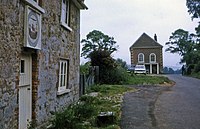Newtown, Isle of Wight
| Newtown | |
|---|---|
 Newtown in 1967. |
|
| Newtown shown within the Isle of Wight | |
| OS grid reference | SZ429901 |
| Unitary authority | |
| Ceremonial county | |
| Region | |
| Country | England |
| Sovereign state | United Kingdom |
| Post town | NEWPORT |
| Postcode district | PO30 |
| Dialling code | 01983 |
| Police | Hampshire |
| Fire | Isle of Wight |
| Ambulance | Isle of Wight |
| EU Parliament | South East England |
| UK Parliament | |
Newtown is a small hamlet on the Isle of Wight, England. In medieval times it was a thriving borough. According to the Post Office the 2011 Census population of the hamlet was included in the civil parisih of Calbourne.
Newtown is located on the large natural harbour on the island's north-western coast, now mostly a national nature reserve owned and managed by the National Trust.
The Caul Bourne stream through Calbourne passes Newbridge and Shalfleet and empties into the Solent at Newtown.
The town was originally called Francheville (i.e. 'Freetown'), and only later renamed Newtown. It was probably founded before the Norman Conquest. There is some indication that it was attacked by Danes in 1001.
The earliest known charter was granted by the Bishop-elect of Winchester, Aymer de Valence. He signed it at his ecclesiastical estate of Swainston Manor in 1256. The early hopes for its success are reflected in the names of its streets, such as Gold Street and Silver Street. However, it will have had competition from Yarmouth, Newport and Southampton. In 1284 it was somewhat reluctantly given to Edward I. Apparently there were about 60 families living in Newtown at the start of the 14th century.
By the mid 14th century, Newtown was starting to mature into a thriving commercial centre. In 1344, it was assessed at twice the value of Newport. Its harbour was busy and reputed to be the safest on the island. There was a prosperous saltworks and abundant oyster beds. There was an annual three-day festival on the "eve, the day and the morrow of the Feast of St. Mary Magdalen", who was honoured in the name of the local thirteenth-century chapel. Then, the plague struck, and subsequently a French raid in 1377 destroyed much of the town, from which it never recovered.
...
Wikipedia

